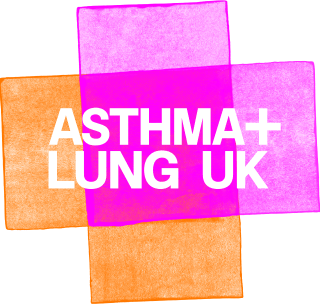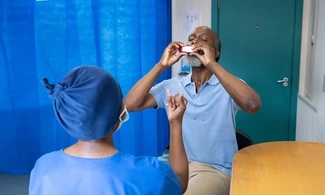- Asthma triggers like pollen, air pollution, dust mites, mould spores, chemicals from products used to deep clean schools and even strong emotions (excitement and fear) can all contribute to the seasonal spike as children return to school
- Exposure to respiratory infections and viruses in the classroom can lead to life-threatening asthma attacks
- A lack of preventer medication routine during the summer holidays can exacerbate asthma symptoms.
Asthma + Lung UK has issued an urgent seasonal alert, as analysis reveals that school children in England are more than five times more likely to end up in hospital with an asthma attack at the start of the new school year.
The most recent official figures show a 408% rise in the number of children aged between five and 14 being admitted to hospital in September compared to August1.
Boys in this age group are more likely to be hospitalised than girls, with records showing that 1,190 boys were admitted to hospital in September 2024 compared to 730 girls, a difference of 48%.2
Dr Andy Whittamore, Clinical Lead at Asthma + Lung UK, and a practising GP, said: “It’s important to stress that September is a dangerous time for all children with asthma, regardless of gender.
“Boys do have narrower airways relative to lung size and stronger immune reactions and responses to allergens, which could all play a part in them having a higher chance of ending up in hospital.
“Vital research is needed to understand why boys are more vulnerable to life-threatening asthma attacks than girls, a trend that completely reverses in adulthood as women are at double the risk of dying from asthma, with female sex hormones believed to be a key factor3.
“September can be a dangerous time for asthma, as colds and flu start to circulate when children return to school. This year’s spike could be worse than usual, with rising rates of measles and respiratory syncytial virus (RSV) putting more children at risk of ending up in hospital with breathing difficulties. This is why we are calling on parents to be prepared.
“Warning signs that a child’s asthma symptoms are worsening include coughing and wheezing, especially at night or early in the morning, breathlessness, complaining about chest or stomach pain, or needing their reliever inhaler (usually blue) three or more times a week.”
If you are a parent or carer of a child with asthma, you can help reduce the risk of a September asthma attack by taking the following precautions:
- Make sure your child is using their steroid preventer inhaler as prescribed, as this helps to prevent inflammation in the airways, reducing their risk of an asthma attack. Check too that they have had both MMR (measles, mumps and rubella) vaccinations and contact your GP if one or both have been missed
- Arrange for your child to have an annual asthma review with their GP or asthma nurse as soon as possible. This will pick up early symptoms and can help to identify triggers.
- Check your child has the right asthma medicines and they are taking them in the right way, to manage their asthma and keep them well.
- If your child is at secondary school, make sure they put their reliever inhaler (usually blue) and spacer into their bag before leaving for school every day. They should be kept somewhere they can access during PE or if they are on a school trip.
- Read your child’s school policy on administering medication.
- Have an up-to-date asthma action plan and share it with your child’s school. You can download it here: Your child’s asthma action plan | Asthma + Lung UK
- Make sure your child can use their inhalers correctly and knows when to ask for help. Your GP or asthma nurse can check your child’s inhaler technique at their annual review. Videos are also available on the Asthma + Lung UK website, How to use your inhaler | Asthma + Lung UK or speak to your pharmacist.
- If a child is having an asthma attack and their symptoms are not improving with a reliever inhaler refer to their asthma action plan and then call 999.
Sarah Bage, 37, from Ely, Cambridgeshire, is worried about the return to school after her son Noah, six, had a serious asthma attack last September.
She said: “Noah was hospitalised with asthma for the first time in May 2024, and since then, we’ve had several terrifying trips to A&E. Last September, he became very ill just a few days after starting Year One. He picked up a virus, which I now know to be one of his main triggers and he had to have quite a lot of time off school.
“I’ve learnt to recognise the warning signs, which has helped to keep Noah out of hospital, but the anxiety is constant. When his asthma is getting worse, he doesn’t have a typical wheeze. Instead, he coughs constantly, has trouble sleeping, is emotional, and needs his reliever inhaler more often.
“I am lucky that Noah’s school has been so supportive. All his teachers understand how his asthma presents and have a copy of his asthma action plan. They also know what to do if his symptoms get worse, which is very reassuring. I know we are fortunate as not all schools are as asthma aware. It helps too that Noah can advocate for himself and feels empowered to ask for help.”
Ahead of the new school year, Asthma + Lung UK is calling on headteachers to share their schools’ asthma or medical conditions policies so that parents know how staff will support their child with asthma. These policies should include guidance on how and when schools will inform parents on their child’s inhaler use and asthma symptoms, and where inhalers should be stored. A school’s policy should provide details about staff asthma awareness training, the administration of medication, and emergency procedures so that everyone understands their role in keeping pupils with asthma safe.
The charity wants schools to follow existing guidelines from the Department of Education on managing chronic conditions at school. Schools should ensure the needs of children with asthma and other medical conditions are properly understood and effectively supported.
Asthma + Lung UK is also encouraging school staff to print its free poster, so everyone knows what the steps are if a pupil is having an asthma attack. Asthma at School campaign poster – Asthma + Lung UK
If you are concerned about your child’s asthma, please call Asthma + Lung UK’s helpline 0300 222 5800, which is run with thanks to funds raised by players of the People’s Postcode Lottery.
References:
1. Asthma + Lung UK analysis of bespoke data supplied by NHS England with analysis produced in collaboration with HSJ Information. The 408% increase represents a rise in emergency admissions for asthma in children aged 5-14 from 380 in August 2024 to 1930 in September 2024.
| Ages 5-14 | August | September | x difference | % difference |
| 2020 |
322 |
1771 |
5.5 |
450% |
| 2021 |
315 |
1509 |
4.8 |
379% |
| 2022 |
304 |
1363 |
4.5 |
348% |
| 2023 |
455 |
1370 |
3.0 |
201% |
| 2024 |
380 |
1930 |
5.1 |
408% |
2. Asthma + Lung UK analysis of bespoke data supplied by NHS England with analysis produced in collaboration with HSJ Information. It shows the number of cases of male and female emergency admissions for asthma for children aged 5-14 in August and September 2024 in England. The percentage difference of 48% is calculated by dividing 460 (1190-730) by 960 (1190+73), which equals 0.479.
| 2024 | August | September | x difference | % difference |
| Female |
155 |
730 |
4.7 |
371% |
| Male |
225 |
1190 |
5.3 |
429% |
3. Women almost twice as likely to die from an asthma attack than men. Asthma + Lung UK press release, 2022: https://www.asthmaandlung.org.uk/media/press-releases/women-almost-twice-likely-die-asthma-men







